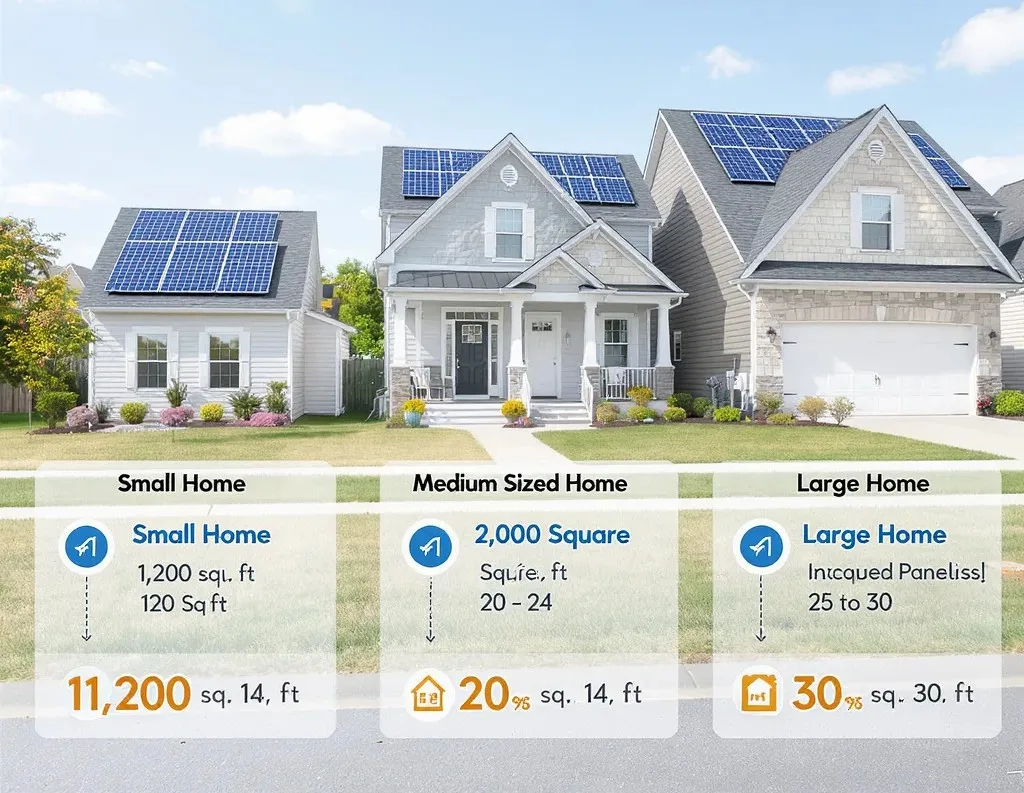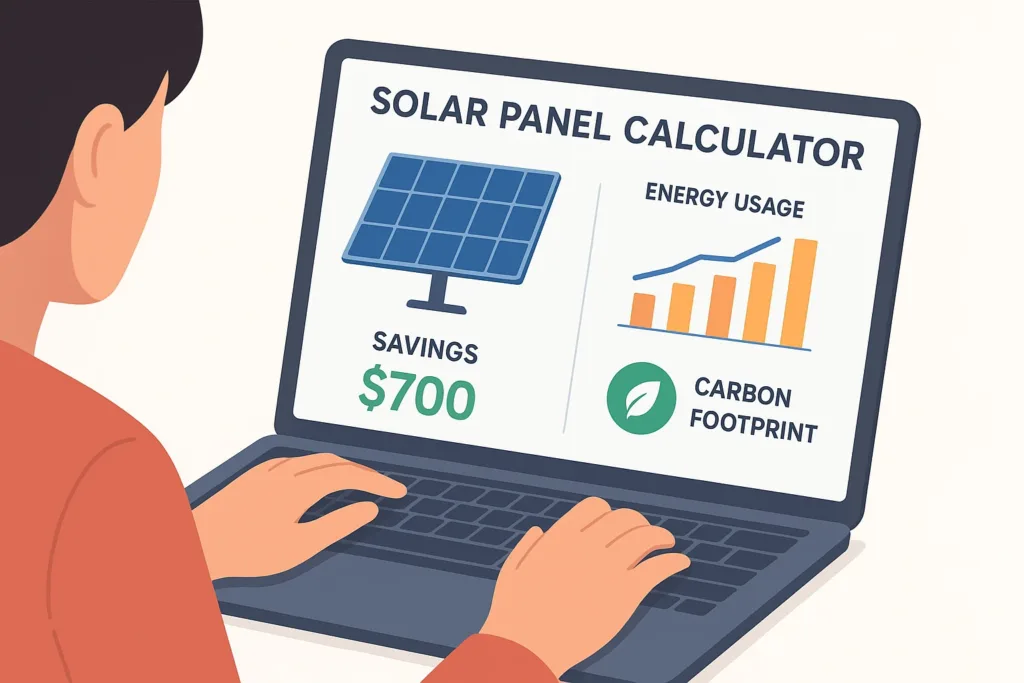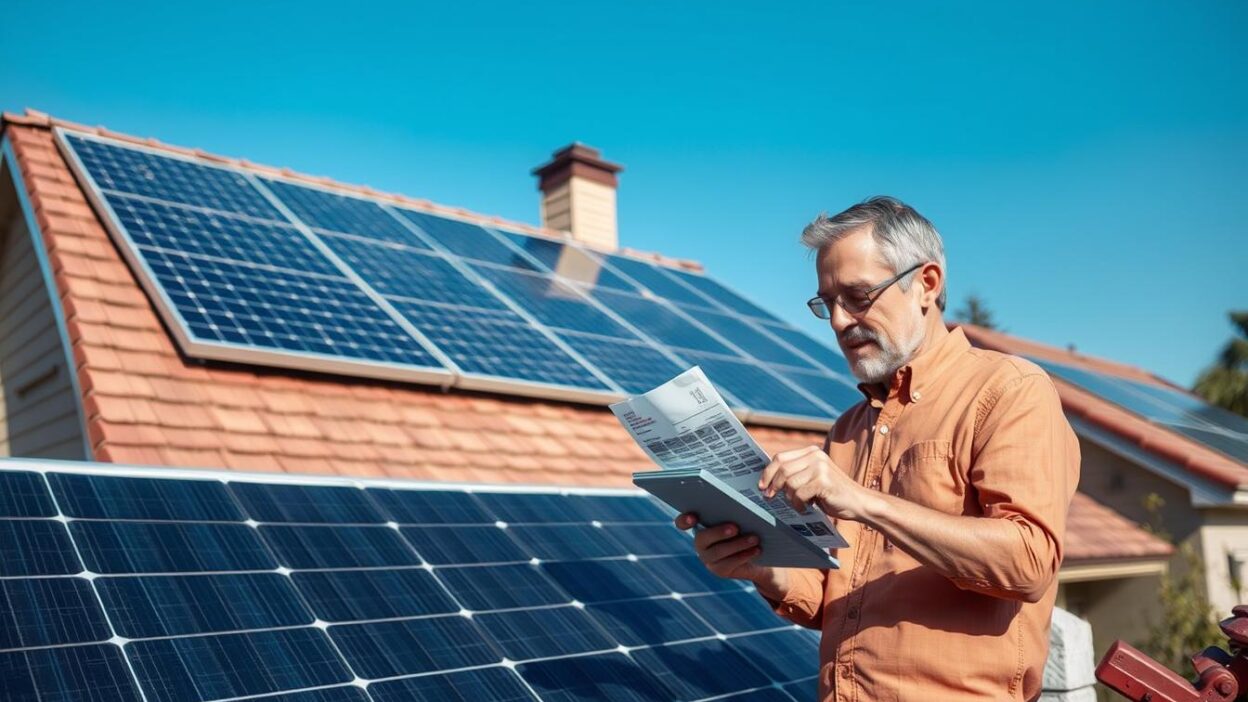Table of Contents
▲If you’re puzzled “how many solar panels do I need?”, you’re not alone. Switching to solar power is a game-changing step toward eco-friendly living, but getting the calculations right is crucial for your investment.
This guide will walk you through the essential factors that determine your solar panel needs. You’ll discover:
- How to calculate your exact panel requirements
- The impact of your home’s size and location
- Ways to account for varying power usage
- Tips for working with limited roof space
An accurate calculation of your solar panel needs can make the difference between an efficient system that meets your energy goals and one that falls short. Using a reliable solar panel calculator helps you avoid common mistakes like:
- Underrating your power requirements
- Installing more panels than necessary
- Failing to account for seasonal variations
- Ignoring location-specific factors
Ready to determine the perfect number of solar panels for your home? Let’s explore the key factors that will shape your solar set-up plan.
Factors Influencing for How Many Solar Panels Do I Need
The number of solar panels needed for your home depends on several key factors that directly impact your energy needs. Let’s explore these essential elements to help you make an informed decision.
1. Average Number of Panels Required for Different Home Sizes
Your home’s size plays a critical role in determining the number of solar panels required for optimal energy production. Here’s a breakdown of typical panel requirements based on home sizes:
Small Homes (1,000-1,500 sq ft)
- Energy usage: 6,000-8,000 kWh/year
- Required panels: 14-18 panels
- Average system size: 4-5 kW
Medium Homes (1,500-2,500 sq ft)
- Energy usage: 9,000-11,000 kWh/year
- Required panels: 20-24 panels
- Average system size: 6-7 kW
Large Homes (2,500+ sq ft)
- Energy usage: 12,000-15,000 kWh/year
- Required panels: 25-30 panels
- Average system size: 8-10 kW
These numbers serve as general guide lines, as actual requirements can vary based on:
- Energy consumption habits
- Local climate conditions
- Panel efficiency ratings
- Roof orientation and angle
- Shade factors
Real-World Example: A 2,000 sq ft home consuming 10,000 kWh annually in a region with 5 peak sun hours per day would need approximately:
10,000 kWh ÷ (365 days × 5 hours) = 5.48 kW system
Using 400-watt panels, this translates to:
5,480 watts ÷ 400 watts = 14 panels
The relationship between home size and panel requirements isn’t always linear. A smaller, energy-efficient home might need fewer panels than a larger home with basic efficiency measures. Energy usage patterns and lifestyle choices often influence panel requirements more than square footage alone.

2. Calculation Method: Determining the Right Panel Quantity
Calculating your exact solar panel needs requires an organized method based on your energy usage. Here’s a practical formula to determine the right quantity:
Calculate Monthly Energy Usage
- Check your electricity bills
- Find average monthly kilowatt-hours (kWh)
- Multiply by 1000 to convert to watts
Account for Panel Wattage
- Standard panels: 250-400 watts
- Divide total needed watts by panel wattage
- Example: 30,000 watts ÷ 300W panel = 100 panels
Factor in Sun Hours
- Multiply daily usage by 1.15 (system losses)
- Divide by sun hours in your location
- Example: 4,000 kWh/month needs:
- 40-45 panels in sunny areas
- 55-60 panels in less sunny regions
Adjust for Efficiency
- Panel efficiency: 15-20%
- Higher efficiency = fewer panels needed
- Premium panels might reduce total count by 20%
This calculation method provides a baseline number. Your specific needs might vary based on:
- Roof angle
- Shade factors
- Local climate patterns
- Energy usage habits
Pro tip: Use your highest monthly usage for calculations to ensure all-year coverage.
3. Considering Roof Size Limitations and High-Efficiency Panels
Your available roof space plays a crucial role in determining your solar panel setup. A typical solar panel measures about 65 x 39 inches, requiring approximately 17.5 square feet per panel. Let’s explore how to make the most of your roof space:
Limited Roof Space Solutions:
- High-efficiency panels (20-23% efficiency)
- Optimized panel positioning
- Multi-story installation options
- Alternative fixing locations
Benefits of High-Efficiency Panels:
- Generate more power in less space
- Reduce installation costs
- Maximize energy production
- Better performance in shaded conditions
Potential Drawbacks:
- Higher upfront costs
- Limited manufacturer options
- More complex maintenance
Space-Saving Tips:
- Remove roof blockage when possible
- Consider removing unused chimneys or vents
- Use smooth installing systems
- Optimize panel angle for maximum exposure
A professional solar analysis can help identify the most efficient panel layout for your specific roof configuration. Some installers use 3D modeling software to create custom designs that maximize your available space while meeting local building codes and structural requirements.
For homes with limited roof space, high-efficiency panels like those from Sun-Power or LG can produce up to 50% more energy per square foot compared to standard panels. This means you can achieve your energy goals with fewer panels, making the most of every inch of available roof space.

4. Geographic Location Impact: Sunlight Hours and Intensity
Your regional location plays a critical role in determining the number of solar panels needed for your home. The amount of sunlight your area receives directly affects your solar system’s power production capability.
Sun Peak Hours by Region:
- Southwest US (Arizona, Nevada): 6-7 hours/day
- Southeast US (Florida, Georgia): 5-6 hours/day
- Northeast US (New York, Maine): 4-5 hours/day
- Pacific Northwest (Washington, Oregon): 3.5-4.5 hours/day
A home in Phoenix might need 20% less panels than a same house in rain-city due to the difference in sunlight intensity. Let’s break this down with a practical example:
A 2,000-square-foot home in Arizona using 1,000 kWh monthly might require 16-18 panels to meet its energy needs. The same house in Washington state could need 20-22 panels to achieve identical power generation.
Seasonal Variation:
- Summer months provide longer daylight hours
- Winter months see reduced sunlight intensity
- Cloud cover affects panel efficiency
- Snow build-up can temporarily decrease production
Your solar installer will factor in these location-specific variables using historical weather data and solar irradiance maps to calculate the optimal number of panels for your home. This ensures your system generates sufficient power throughout the year, accounting for periodic variations in sunlight availability.
5. Additional Factors to Consider Beyond Basic Calculations
Your home’s energy needs aren’t static – they evolve with your lifestyle changes and household modifications. Let’s explore the key factors that can impact your solar panel requirements:
Future Home Improvements
- Adding a swimming pool
- Installing central air conditioning
- Building a home extension
- Converting to an electric vehicle
Seasonal Energy Variations
- Holiday decorations and lighting
- Increased heating/cooling demands
- Pool pump operation in summer
- Additional entertainment systems
Lifestyle Changes
- Growing family size
- Work-from-home arrangements
- New energy-intensive hobbies
- Smart home device integration
Appliance Upgrades
- Energy-efficient replacements
- Additional kitchen tools
- Home automation systems
- Electric water heaters
A practical approach is to add a 25% buffer to your calculated solar panel needs. This extra capacity accommodates future energy demands without requiring system expansion. For example, a household currently using 4000 kWh/month might plan for 5000 kWh/month capacity to account for potential additions like an electric vehicle charging station or a home office setup.
Your solar installation should reflect both your current needs and anticipated changes in energy consumption patterns. This proactive planning ensures your solar system remains effective throughout its 25-30 year lifespan.
Using a Solar Panel Calculator for Accurate Estimation
A solar panel calculator is an online tool that helps you determine how many solar panels you need for your home. It takes into account various factors such as your energy consumption, location, and roof specifications to provide you with accurate estimates.
How to Use a Solar Panel Calculator accurately.
Here is a step-by-step guide on how to use a solar panel calculator:
1. Gather Your Energy Data
Before using the calculator, make sure you have the following information:
- Collect past 12 months of electricity bills
- Calculate average monthly energy consumption
- Note seasonal variations in usage
2. Input Location Details
The calculator requires specific details about your location:
- Enter your complete address
- Specify roof orientation (south-facing is ideal)
- Indicate roof pitch angle if known
3. Define System Preferences
You can customize the calculator based on your preferences:
- Select desired energy offset percentage
- Choose preferred panel type
- Specify budget constraints
4. Measure Available Space
To get accurate results, measure the available space for solar panels:
- Input roof dimensions
- Mark areas with shade or obstructions
- Include setback requirements per local codes
Consider any additional factors that may affect your solar system:
- Select inverter type
- Add battery storage requirements
- Include any specific energy goals
What Happens Next?
Once you enter all the required information, the calculator will process it using complex algorithms. These algorithms take into account various factors such as:
- Solar irradiance data for your location, which is essential for understanding how much sunlight your area receives.
- Panel efficiency ratings, which can vary based on multiple factors including the spectrum of light received as detailed in this study.
- System losses (due to wiring, inverter, etc.)
- Local weather patterns
- Shading factors (if applicable)
Understanding Calculator Results
After processing the inputs, the calculator will provide you with the following results:
- Recommended number of panels
- Estimated system size in kilowatts (kW)
- Expected energy production
- Potential cost savings
- Carbon offset metrics
Tips for Accurate Calculations
To ensure more accurate calculations, consider the following tips:
- Use recent energy bills for current consumption patterns
- Include future energy needs in your calculations (e.g., electric vehicle charging)
- Consider seasonal variations in your area (e.g., higher energy usage during summer months)
- Account for any planned electrical additions (e.g., new appliances)
A solar panel calculator provides fact-based recommendations based on your specific situation. This personalized approach ensures you receive accurate estimates customized to your home’s unique characteristics and energy requirements.

Final Thought
Accurate solar panel calculations are essential for a successful solar power system. By thoroughly evaluating your household electricity usage and considering the local solar potential, you can estimate your solar panel requirements with confidence.
The number of solar panels you need depends on several key factors:
- Energy Usage Patterns: Your monthly electricity consumption
- Geographic Location: Available sunlight hours and intensity
- Roof Space: Available area for panel installation
- Panel Efficiency: The wattage output of selected panels
Professional solar calculators can simplify this process by analyzing these variables to determine the ideal number of panels for your specific situation. This fact-based approach ensures that your investment in solar energy aligns with both your energy needs and the characteristics of your property.
Switching to solar power is an important step towards becoming more independent and environmentally friendly. By understanding exactly how many panels you require, you can create a modified solar solution that maximizes both the positive impact on the planet and your financial returns. With these accurate calculations in hand, you’ll be well-prepared to explore different options for solar panels and installation setups that suit your unique circumstances.
How many solar panels are required to run a house?
On average, a typical home needs 15–25 solar panels (400W each) to cover normal electricity use, depending on energy consumption, location, and sunlight hours
What is the best size solar system for a house?
The best size solar system for a house is typically 5–10 kW, depending on electricity usage and sunlight in your area.
How many solar panels for 1.5 ton AC?
A 1.5-ton AC needs about 5–10 solar panels (400W each), depending on inverter type, usage hours, and batteries.
Is 10KW enough to run a house?
Yes, a 10 kW solar system is enough for most homes, covering about 30–40 kWh/day (typical household use).
Can I run 2 AC on a 5kW solar system?
Yes, a 5kW solar system can run 2 ACs, but only if they are inverter ACs (1–1.5 ton each) and used during peak sunlight hours. Running both at night will require a large battery bank.




